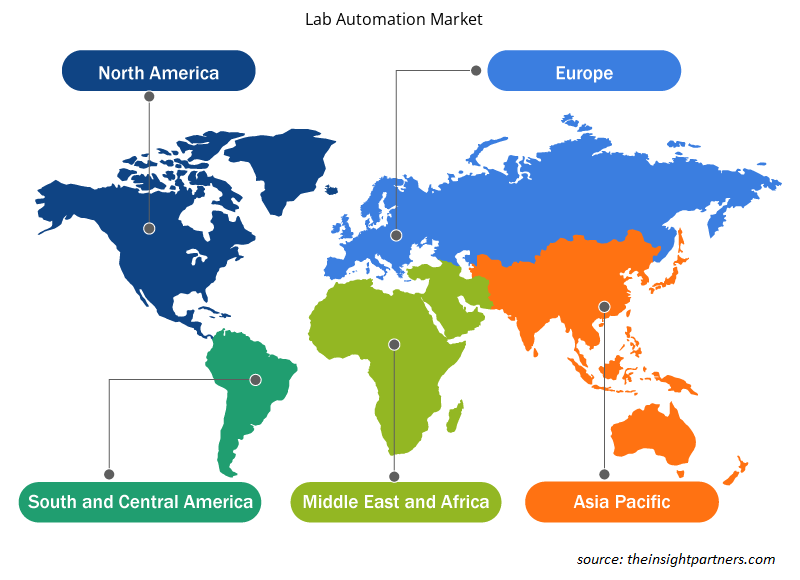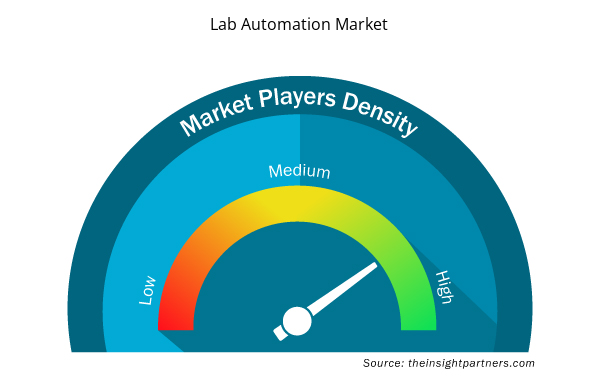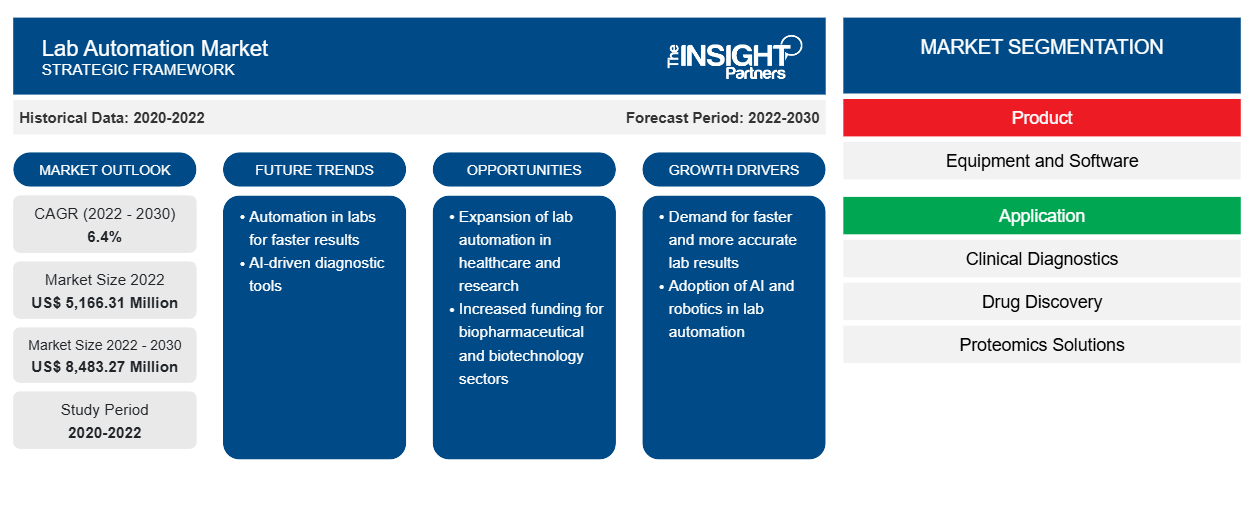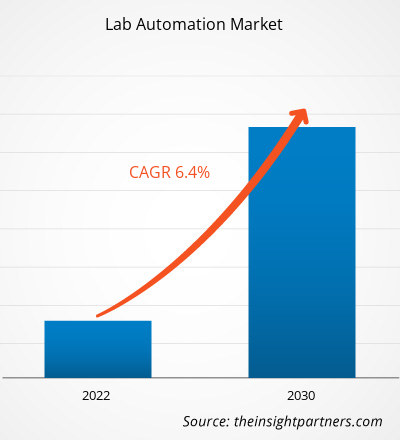[研究报告] 实验室自动化市场规模预计将从 2022 年的 51.6631 亿美元增长到 2030 年的 84.8327 亿美元;预计 2022 年至 2030 年的复合年增长率为 6.4%。
实验室自动化市场洞察和分析师观点:
将自动化集成到实验室中以实现新的和增强的实验室流程被称为实验室自动化。实验室机器人是实验室自动化技术最著名的用途。此外,实验室自动化涵盖了广泛的自动化实验室仪器、设备、软件算法和方法,用于实现、加速和提高实验室研究的效率。根据实验室自动化市场分析,推动实验室自动化市场发展的关键因素是实验室自动化和不断发展的制药行业提供的不断增长的应用和优势。然而,由于高资本投入导致实验室自动化的采用有限,阻碍了实验室自动化市场的增长。
增长动力和限制因素:
生物技术、制药、临床诊断、学术研究和环境测试是实验室自动化程度不断提高的主要行业。对实验室程序效率、精度和吞吐量的要求推动了对实验室自动化的需求。自动化技术的使用提供了各种好处,可以对科学研究和开发的生产力和质量产生重大影响。各种关键优势和应用包括高通量筛选、样品制备和处理、数据管理和集成、工作流程优化、灵活性和定制、质量控制和保证、资源优化、长期成本节约、减少危险化学品或生物材料的人工处理以及扩大实验室的容量和能力。因此,实验室自动化变得越来越有利,这凸显了它如何改变各个行业的科学研究和开发。预计随着技术的发展,实验室自动化将会增加,从而推动科学计划的效率和创新。
然而,由于高昂的资本支出,各家公司(尤其是生物技术和制药行业的公司)在采用实验室自动化时遇到了重大问题。虽然实验室自动化提供了各种好处,例如更高的效率、准确性和吞吐量,但部署自动化系统的初始成本对于某些企业来说可能是难以承受的。各种因素导致实验室自动化所需的高资本投资,例如设备成本、基础设施要求、集成和定制、维护和支持、高专业知识要求以及技术过时的风险。例如,根据 Retisoft Inc. 的数据,小型自动化机器人系统的价格范围在 100,000 美元到 300,000 美元之间。然而,更复杂和更大的实验室自动化系统的成本通常超过 100 万美元。因此,实验室自动化所需的高资本投资可能会阻碍许多生物技术和制药公司采用实验室自动化,尤其是资金有限的小型或新兴组织。因此,上述因素可能会阻碍全球实验室自动化市场的增长。
定制此报告以满足您的需求
您可以免费定制任何报告,包括本报告的部分内容、国家级分析、Excel 数据包,以及为初创企业和大学提供优惠和折扣
- 获取此报告的关键市场趋势。这个免费样品将包括数据分析,从市场趋势到估计和预测。
报告细分和范围:
全球实验室自动化市场报告根据产品、应用和最终用户进行细分。根据产品,实验室自动化市场分为设备和软件。根据设备,市场细分为自动化工作站、微孔板读取器、机器人系统、现成的自动化工作单元、自动化存储和检索系统 (ASRS) 等。根据软件,市场细分为实验室执行系统 (LES)、实验室信息管理系统 (LIMS)、电子实验室笔记本 (ELN) 和科学数据管理系统 (SDMS)。根据应用,实验室自动化市场分为临床诊断、药物发现、蛋白质组学解决方案、基因组学解决方案等。根据最终用户,实验室自动化市场分为制药公司、医院和诊断中心、教育和研究机构以及合同研究组织。实验室自动化市场报告根据地理位置分为北美(美国、加拿大和墨西哥)、欧洲(德国、法国、意大利、英国、俄罗斯和欧洲其他地区)、亚太地区(澳大利亚、中国、日本、印度、韩国和亚太地区其他地区)、中东和非洲(南非、沙特阿拉伯、阿联酋和中东和非洲其他地区)以及南美洲和中美洲(巴西、阿根廷和南美洲和中美洲其他地区)。
节段分析:
根据产品,实验室自动化市场分为设备和软件。2022 年,设备部分在实验室自动化市场中占有较大份额。然而,根据实验室自动化市场预测,软件部分预计在 2022-2030 年期间的复合年增长率更高。
根据设备,实验室自动化市场细分为自动化工作站、液体处理系统、机器人系统、微孔板读取器、自动存储和检索系统 (ASRS) 等
根据应用,实验室自动化市场分为临床诊断、药物发现、 蛋白质组学解决方案、基因组学解决方案等。药物发现部分在 2022 年实验室自动化市场规模中占有最大份额。然而,根据实验室自动化市场预测,临床诊断部分预计将在 2022 年至 2030 年期间实现最高复合年增长率。
根据最终用户,实验室自动化市场细分为制药公司、医院和诊断中心、教育和研究机构以及合同研究组织。2022 年,制药公司部门在实验室自动化市场规模中占有最大份额。然而,根据实验室自动化市场预测,医院和诊断中心部门预计将在 2022-2030 年期间实现最高复合年增长率。
区域分析:
根据地理位置,全球实验室自动化市场分为五个主要区域:北美、欧洲、亚太地区、南美和中美以及中东和非洲。
2022 年,北美占据了全球实验室自动化市场规模的最大份额。美国医疗基础设施的发展和医疗服务支出的增加正在推动该国实验室自动化市场的发展。实验室自动化在临床试验、药物开发和生物医学研究中的使用对实验室自动化市场的增长产生了重大影响。这些系统还可以在很少的监督和指导下长时间运行,使研究人员能够专注于他们的主要工作,而花更少的时间在重复性活动上。此外,美国医疗保险和医疗补助服务中心 (CMS) 根据《临床实验室改进修正案》(CLIA) 采用了与人体实验室研究相关的标准,这促进了实验室自动化市场的增长。
实验室自动化市场区域洞察
Insight Partners 的分析师已详尽解释了预测期内影响实验室自动化市场的区域趋势和因素。本节还讨论了北美、欧洲、亚太地区、中东和非洲以及南美和中美洲的实验室自动化市场细分和地理位置。

- 获取实验室自动化市场的区域特定数据
实验室自动化市场报告范围
| 报告属性 | 细节 |
|---|---|
| 2022 年市场规模 | 51.6631亿美元 |
| 2030 年市场规模 | 84.8327亿美元 |
| 全球复合年增长率(2022 - 2030 年) | 6.4% |
| 史料 | 2020-2022 |
| 预测期 | 2022-2030 |
| 涵盖的领域 | 按产品
|
| 覆盖地区和国家 | 北美
|
| 市场领导者和主要公司简介 |
|
实验室自动化市场参与者密度:了解其对业务动态的影响
实验室自动化市场正在快速增长,这得益于最终用户需求的不断增长,而这些需求又源于消费者偏好的不断变化、技术进步以及对产品优势的认识不断提高等因素。随着需求的增加,企业正在扩大其产品范围,进行创新以满足消费者的需求,并利用新兴趋势,从而进一步推动市场增长。
市场参与者密度是指在特定市场或行业内运营的企业或公司的分布情况。它表明在给定市场空间中,相对于其规模或总市场价值,有多少竞争对手(市场参与者)存在。
在实验室自动化市场运营的主要公司有:
- 西门子医疗
- 赛默飞世尔科技公司
- 耶拿分析仪器有限公司
- 莱伯曼自动化有限公司
- 屋宇署
免责声明:上面列出的公司没有按照任何特定顺序排列。

- 获取实验室自动化市场顶级关键参与者概述
行业发展和未来机遇:
以下列出了全球实验室自动化市场主要参与者采取的各种举措:
- 2023 年 5 月,Opentrons 宣布推出 Opentrons Flex 机器人,这是一类创新型价格合理、易于编程的液体处理实验室机器人,它将为各种规模的实验室提供公平的竞争环境,并使更多的研究人员能够使用先进的实验室自动化。Flex 机器人将尖端机器人技术与庞大的开源软件生态系统相结合。它可以与 AI 工具一起使用,并且具有几乎无限的新协议选择能力。
- 2023 年 3 月,Brooks Automation US, LLC 宣布收购 Aim Lab Automation Technologies Pty Ltd。Brooks 收购 Aim Lab 符合该公司在实验室自动化市场提供更多解决方案的扩张计划。凭借其 PreciseFlex 产品解决方案,Brooks 引领了生命科学协作自动化市场。通过此次收购,Brooks 在临床诊断领域的地位已超越药物发现。借助 PreciseFlex,Aim Lab 将为其客户提供更多功能、全球影响力以及更紧密合作的机会。
- 2023 年 2 月,Automata 推出了 LINQ,这是一个新的开放式集成实验室自动化平台。LINQ 平台包括一个专用实验台,内置自动化工具和强大的内部实验室编排软件。因此,实验室可以提高效率和准确性,同时减少人为接触点的数量,而无需为大型复杂设备增加更多空间。
- 2023 年 1 月,BD(碧迪公司)为 BD Kiestra 微生物实验室解决方案推出了机器人轨道系统。该系统可实现实验室标本处理的自动化,从而最大程度地减少人力劳动并缩短等待时间。借助全新的 BD Kiestra 第三代全实验室自动化系统,实验室可以连接各种 BD Kiestra 模块,构建独特且适应性强的全实验室自动化配置。它还具有可扩展性,可满足实验室不断变化的需求。通过从各种轨道配置和机器中进行选择,实验室可以定制自动化系统,以匹配其独特的工作流程和物理实验室空间。
- 2022 年 6 月,Insilico Medicine 推出了一个由 AI 运行的机器人实验室。这是 Insilico 端到端 AI 驱动的药物发现平台的现实世界互联扩展。它将由其 AI 系统远程控制,由自动导引车代替人类科学家进行实验。这些机器人将进行细胞培养、高通量筛选、下一代测序、细胞成像以及基因组学分析和预测。
- 2021 年 5 月,贝克曼库尔特宣布在全球推出 DxA 5000 Fit。DxA 5000 Fit 是一种工作流程自动化系统,适用于每天执行少于 5,000 次测试的中型实验室。
竞争格局和重点公司:
西门子医疗、赛默飞世尔科技、耶拿分析有限公司、Labman Automation Ltd、BD、Brooks Automation Inc、bioMerieux SA、CrelioHealth Inc.、丹纳赫集团和 F. Hoffmann-La Roche Ltd 是实验室自动化市场的知名企业。这些公司专注于新技术、现有产品的改进和地域扩张,以满足全球日益增长的消费者需求,并扩大其专业产品组合的范围。
- 历史分析(2 年)、基准年、预测(7 年)及复合年增长率
- PEST 和 SWOT 分析
- 市场规模价值/数量 - 全球、区域、国家
- 行业和竞争格局
- Excel 数据集



Report Coverage
Revenue forecast, Company Analysis, Industry landscape, Growth factors, and Trends

Segment Covered
This text is related
to segments covered.

Regional Scope
North America, Europe, Asia Pacific, Middle East & Africa, South & Central America

Country Scope
This text is related
to country scope.
Trends and growth analysis reports related to Technology, Media and Telecommunications : READ MORE..
The List of Companies - Lab Automation Market
- Siemens Healthineers
- Thermo Fisher Scientific Inc
- Analytik Jena GmbH+Co. KG
- Labman Automation Ltd
- BD
- Brooks Automation Inc
- bioMerieux SA
- CrelioHealth Inc.
- Danaher Corporation
- F. Hoffmann-La Roche Ltd
The Insight Partners performs research in 4 major stages: Data Collection & Secondary Research, Primary Research, Data Analysis and Data Triangulation & Final Review.
- Data Collection and Secondary Research:
As a market research and consulting firm operating from a decade, we have published and advised several client across the globe. First step for any study will start with an assessment of currently available data and insights from existing reports. Further, historical and current market information is collected from Investor Presentations, Annual Reports, SEC Filings, etc., and other information related to company’s performance and market positioning are gathered from Paid Databases (Factiva, Hoovers, and Reuters) and various other publications available in public domain.
Several associations trade associates, technical forums, institutes, societies and organization are accessed to gain technical as well as market related insights through their publications such as research papers, blogs and press releases related to the studies are referred to get cues about the market. Further, white papers, journals, magazines, and other news articles published in last 3 years are scrutinized and analyzed to understand the current market trends.
- Primary Research:
The primarily interview analysis comprise of data obtained from industry participants interview and answers to survey questions gathered by in-house primary team.
For primary research, interviews are conducted with industry experts/CEOs/Marketing Managers/VPs/Subject Matter Experts from both demand and supply side to get a 360-degree view of the market. The primary team conducts several interviews based on the complexity of the markets to understand the various market trends and dynamics which makes research more credible and precise.
A typical research interview fulfils the following functions:
- Provides first-hand information on the market size, market trends, growth trends, competitive landscape, and outlook
- Validates and strengthens in-house secondary research findings
- Develops the analysis team’s expertise and market understanding
Primary research involves email interactions and telephone interviews for each market, category, segment, and sub-segment across geographies. The participants who typically take part in such a process include, but are not limited to:
- Industry participants: VPs, business development managers, market intelligence managers and national sales managers
- Outside experts: Valuation experts, research analysts and key opinion leaders specializing in the electronics and semiconductor industry.
Below is the breakup of our primary respondents by company, designation, and region:

Once we receive the confirmation from primary research sources or primary respondents, we finalize the base year market estimation and forecast the data as per the macroeconomic and microeconomic factors assessed during data collection.
- Data Analysis:
Once data is validated through both secondary as well as primary respondents, we finalize the market estimations by hypothesis formulation and factor analysis at regional and country level.
- Macro-Economic Factor Analysis:
We analyse macroeconomic indicators such the gross domestic product (GDP), increase in the demand for goods and services across industries, technological advancement, regional economic growth, governmental policies, the influence of COVID-19, PEST analysis, and other aspects. This analysis aids in setting benchmarks for various nations/regions and approximating market splits. Additionally, the general trend of the aforementioned components aid in determining the market's development possibilities.
- Country Level Data:
Various factors that are especially aligned to the country are taken into account to determine the market size for a certain area and country, including the presence of vendors, such as headquarters and offices, the country's GDP, demand patterns, and industry growth. To comprehend the market dynamics for the nation, a number of growth variables, inhibitors, application areas, and current market trends are researched. The aforementioned elements aid in determining the country's overall market's growth potential.
- Company Profile:
The “Table of Contents” is formulated by listing and analyzing more than 25 - 30 companies operating in the market ecosystem across geographies. However, we profile only 10 companies as a standard practice in our syndicate reports. These 10 companies comprise leading, emerging, and regional players. Nonetheless, our analysis is not restricted to the 10 listed companies, we also analyze other companies present in the market to develop a holistic view and understand the prevailing trends. The “Company Profiles” section in the report covers key facts, business description, products & services, financial information, SWOT analysis, and key developments. The financial information presented is extracted from the annual reports and official documents of the publicly listed companies. Upon collecting the information for the sections of respective companies, we verify them via various primary sources and then compile the data in respective company profiles. The company level information helps us in deriving the base number as well as in forecasting the market size.
- Developing Base Number:
Aggregation of sales statistics (2020-2022) and macro-economic factor, and other secondary and primary research insights are utilized to arrive at base number and related market shares for 2022. The data gaps are identified in this step and relevant market data is analyzed, collected from paid primary interviews or databases. On finalizing the base year market size, forecasts are developed on the basis of macro-economic, industry and market growth factors and company level analysis.
- Data Triangulation and Final Review:
The market findings and base year market size calculations are validated from supply as well as demand side. Demand side validations are based on macro-economic factor analysis and benchmarks for respective regions and countries. In case of supply side validations, revenues of major companies are estimated (in case not available) based on industry benchmark, approximate number of employees, product portfolio, and primary interviews revenues are gathered. Further revenue from target product/service segment is assessed to avoid overshooting of market statistics. In case of heavy deviations between supply and demand side values, all thes steps are repeated to achieve synchronization.
We follow an iterative model, wherein we share our research findings with Subject Matter Experts (SME’s) and Key Opinion Leaders (KOLs) until consensus view of the market is not formulated – this model negates any drastic deviation in the opinions of experts. Only validated and universally acceptable research findings are quoted in our reports.
We have important check points that we use to validate our research findings – which we call – data triangulation, where we validate the information, we generate from secondary sources with primary interviews and then we re-validate with our internal data bases and Subject matter experts. This comprehensive model enables us to deliver high quality, reliable data in shortest possible time.


 获取此报告的免费样本
获取此报告的免费样本